Homo Sapien Tribes
Bacho Kiro Cave, Bulgaria
The Bacho Kiro cave, near Dryanovo, Bulgaria, is a fairy tale scene. Four stories high with an intricate mix of galleries and corridors, the cave stretches 2 1/4 miles long and has a huge number of stalactites and stalagmites. Over 100 datasets of Carbon-14 has dated Homo sapiens inhabiting the cave for over 10,000 years! The earliest group of Homo sapiens are dated between 46,000 to 40,000 years ago.

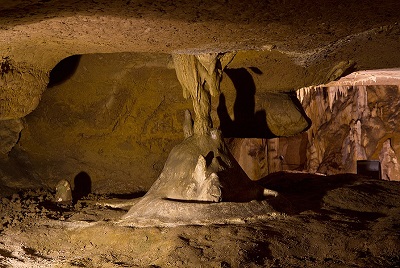
The fossil record was sparse from the cave but DNA analysis from 3 separate individuals showed conclusively that they were Homo sapiens who had up to 3.8% Neanderthal genes indicating Neanderthal admixture within the previous 6 generations.
It's interesting that these oldest Homo sapiens did not contribute to the European Homo sapiens gene pool, instead we can trace their descendants to East Asians and South America. This could mean that when this group of Homo sapiens left Bacho Kiro cave they migrated to the East; or it may mean that they were a Western branch of Asian Homo sapiens.
Later, around 35,000 years ago, another group of Homo sapiens inhabited the cave and their DNA show similarities to European Homo sapiens.
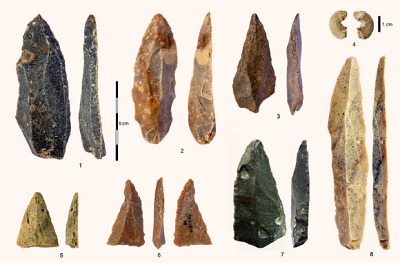
Many animal bones bore the cut-marks characteristic of butchering. They left the cave's floor littered with bones from butchered bison, wild horses and cave bears. It also revealed a large collection of stone and bone tools, personal ornamentation made from cave bear teeth, ivory and stone beads. The ivory bead and cave bears teeth were perforated, likely to be worn as pendants. Some of the stone blades and bone tools were stained with red ochre for decoration.
Ochre is a mineral contained in hematite rock. The rock can be ground into powder using a coarse piece of stone and then mixed with water, egg yolk or even clay to make a form of paint. It can also be made into a stick and used as a crayon. This ochre was used to decorate stone tools and perhaps to stain clothing or as body paint. Burial sites with the bones covered in ochre are found where the ochre seems to have been sprinkled over the body in some form of burial ceremony. Ochre ranges in color from yellow to deep orange, red and brown. The earliest use of Ochre dates to 200,000 years ago at a Neanderthal site in the Netherlands where flint and bone fragments have remnants of red ochre on them. Later, ochre was used in the famous cave paintings found in France and Spain.
Based upon the fossil record alone Homo sapiens lived throughout Europe and eastward into the Far East as early as 56,000 years. It's only when we add in the conclusive science of DNA analysis that we date the 'earliest' Homo sapiens at Bacho Kiro cave to 46,000 years ago. Indeed fossils from the Bacho Kiro cave show Homo sapiens inhabiting the cave for several thousand years before the date confirmed by DNA.
Tianyuan Cave near Beijing, China
Continuing on with DNA analysis of early Homo sapiens shows the enormous range of inhabitation; in 2003 DNA was extracted and anyalysed from 40,000 year old fossils from Tianyuan Cave about 50 km southwest of Beijing, China. The DNA analysis shows some Neanderthal genes (up to 4%) but no Denisovan components. DNA sequences determined that the Tianyuan individual was a distant relative to many present-day Asians living in China, Japan, North and South Korea and throughout Southeast Asia including Papua New Guinea and Australia.; the Tianyuan man was also a distant relative to Native American tribes living today in the Brazilian Amazon but not of North American Indian tribes! This calls into question the accepted migration path over the Beringia land mass connecting Alaska and Russia and opens up the distinct possibility of ocean migration - perhaps from Australia to Peru by sea!
It was a surprise that a 35,000-year-old individual from Belgium shared some genetic similarity to the Tianyuan individual that no other ancient Europeans shared. It's unlikely that this is due to direct interactions between the two Homo sapiens tribe but rather derived from a common ancestor prior to the separation of the European and Asian Homo sapiens. This illustrates how complex ancient migrations were.
Kostenki, Russia
In the Pokrovsky Valley of Russia about 250 miles south of Moscow a series of 26 open air encampments have been excavated. Located on a plain between the west bank of the Don River and some hills this area was inhabited by Homo sapiens for 15,000 years.
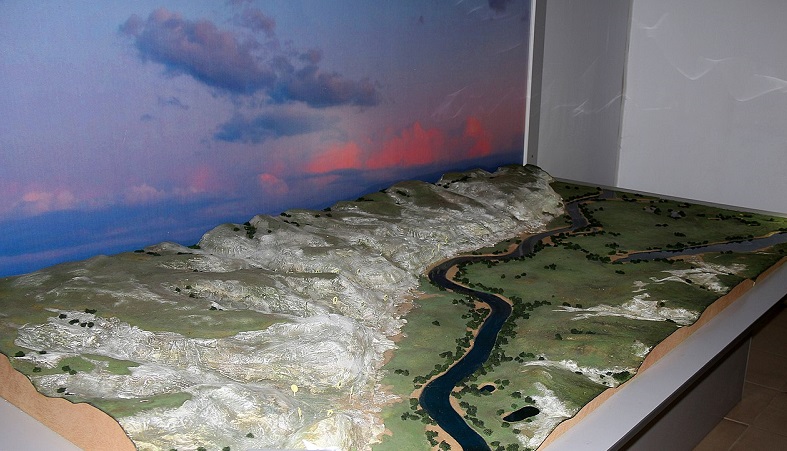
Terrain Model of the Kostenki settlement
Some artifacts have been found below a layer of Campanian volcanic ash which is dated 45,000 years ago meaning that Homo sapiens inhabited the site before that date. With multiple DNA sequences done the oldest DNA confirmed Homo sapien fossils are from 40,000 to 35,000. One had a close relationship the Mal'ta boy in south-east Siberia who dates to 24,000 year ago. Also a clear link into the much later European hunter-gatherers during the Neolithic as well as being ancestral to Early European Farmers; but not to East Asians. There was some Neanderthal admixture

Kostenki had a high concentration of artifacts including a quite sophisticated tool kit of burins, antler tools, ivory artifacts and shell ornaments. Also some prismatic blades which is a long, narrow, specialized stone flake tool with a sharp edge, like a small razor blade.
The Kostenki settlements stone points were often fashioned with a 'shoulder' or tang. The graphic to the right shows a collection of these shoulder points from Kostenki settlement 21/III. These shoulders were used to mount the blade on a stick. Depending on the size of the point the finished product would be a knife, a spear or an arrow head.
Below is an example of a shouldered point when mounted and used as a knife. The stone points are razor sharp and very effective
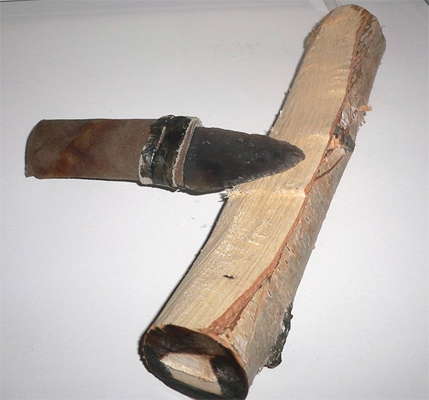 Ornamentations such as necklaces of fox teeth and a diadem headband were found. Note the perforations in the diadem which was held in place with a leather strip.
Ornamentations such as necklaces of fox teeth and a diadem headband were found. Note the perforations in the diadem which was held in place with a leather strip.


Along with other sites such as Byzovaya and Mamontovaya Kurya, Kostenki clearly show that ancient Homo sapiens lived throughout the eastern plains of Russia at a very early time period.
Goyet Caves Belgium
The oldest DNA in Western Europe is dated 35,000 years ago and comes the from a man's humerus (upper arm). While the archeological record in the cave for this time period is sparse the DNA reavealed that this Homo sapien directly contributed to the ancestry of present-day Europeans. This tribe of Homo sapiens were displaced about 33,000 years ago by another group of genetically distinct Homo sapiens but did survive and reappeared in Spain. About 19,000 years ago they spread throughout all of Europe to the extent they could be called the Founding Fathers of Europe.
Ancestral Home of Modern Europeans (pictured in 1886)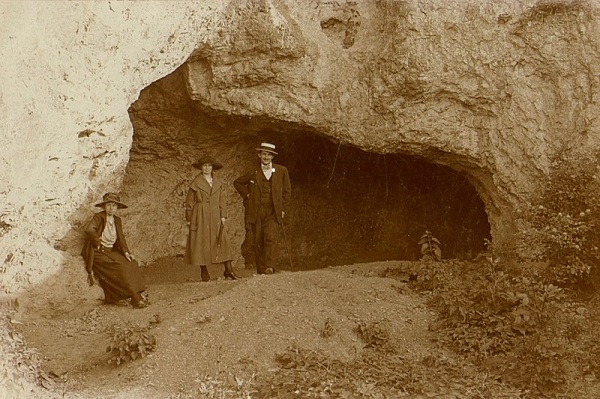
Neanderthals inhabited the Goyet Caves for thousands of years before Homo sapiens. A large collection of 99 bones from this Neanderthal inhabitation showed that they practiced cannabalism. Bones from horses, reindeer as well as a newborn Neanderthal child and four adults who lived around 40,000 years ago show clear signs of cutting and fracturing in order to extract the bone marrow. "It is irrefutable, cannibalism was practised here," said Belgian archaeologist Christian Casseyas who also leads public tours of the caves. Both the Neanderthals and Homo sapiens lived during an Ice Age; huge glaciers extended as far south as France making a deadly, inhospitable climate. There is little doubt that at times food was scarce although some speculate that this cannabalism may have been some form of ritual.
African DNA
In comparison, the oldest Africa Homo sapiens confirmed by DNA is 15,000 years ago. These early African Homo sapiens lived in the Grotte des Pigeons cave near Oujda, Morocco starting about 22,000 years ago based upon Carbon-14 dating of related artifacts from the cave. Oujda is close to the Mediterranean Sea on the border with Algeria. DNA from the ear bones of skeletons found no genetic ties to ancient Europeans. Instead, they are primarily related to the slightly younger Natufian culture in the Middle East and with about one third of their genetic make up coming from the West coast of Africa and Tanzania. This shows that both groups inherited their shared DNA from a tribe of Homo sapiens that lived in one of the two locations, North Africa or the Middle East, more than 15,000 years ago.
